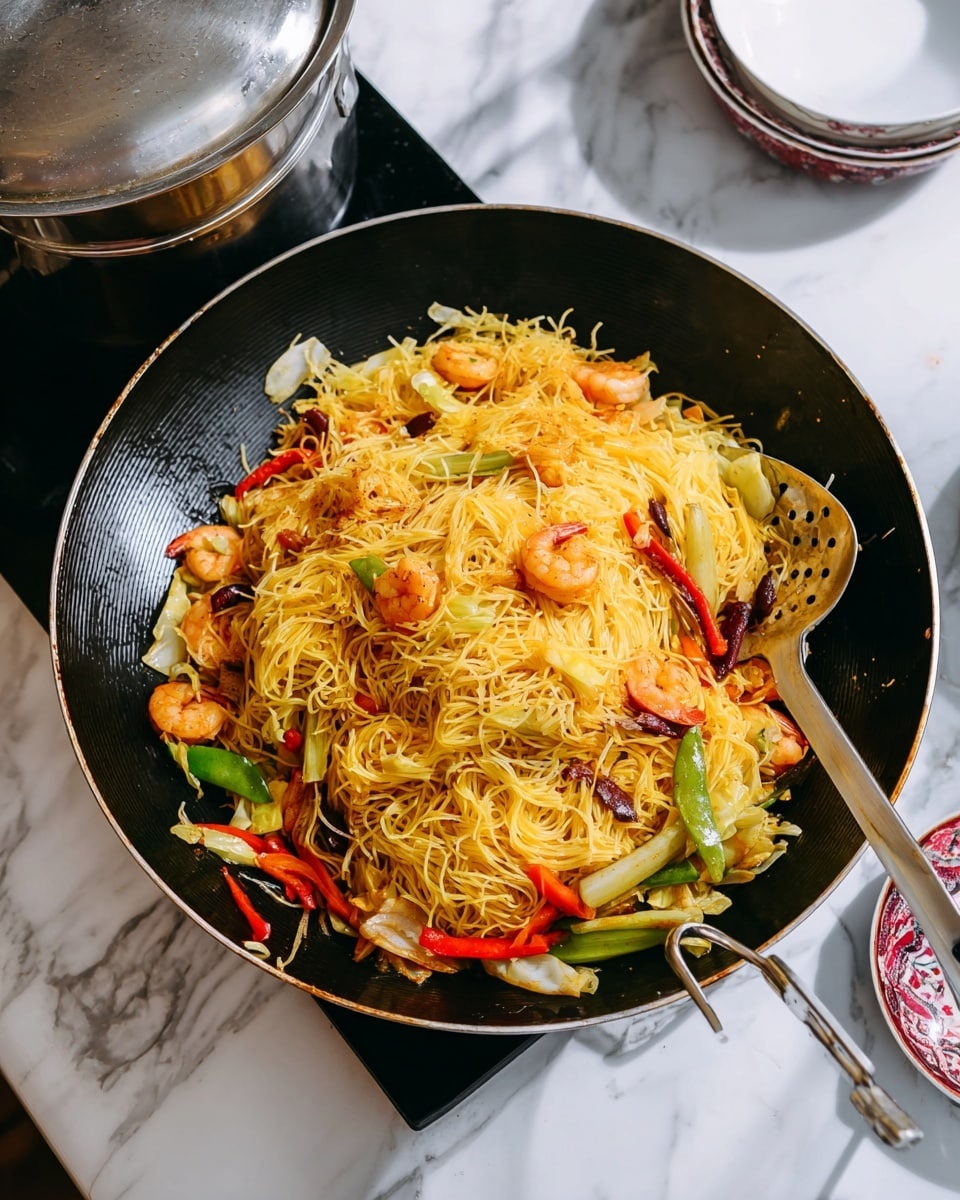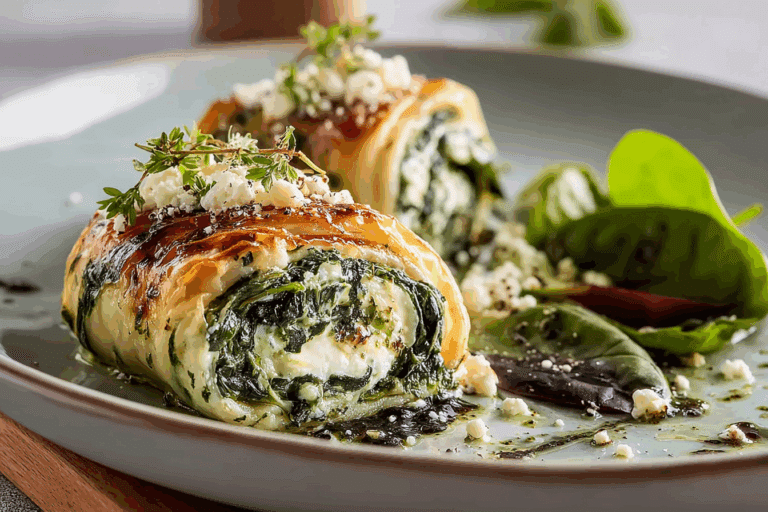Singapore Rice Noodles Recipe
Whenever I crave that perfect balance of flavors in a stir-fry, my go-to is this Singapore Rice Noodles Recipe. It’s a vibrant dish packed with shrimp, char siu pork, colorful veggies, and just the right touch of curry powder that makes each bite sing. Trust me, if you love quick but impressive meals, this recipe will be your new kitchen favorite.
What I adore about this Singapore Rice Noodles Recipe is how effortlessly it brings a taste of one of my favorite street foods into my home kitchen. It works amazingly well for a fast weeknight dinner yet feels special enough to share with friends on the weekend. Plus, the mix of textures and flavors means you’ll never get bored!
Ingredients You’ll Need
These ingredients combine to create a perfectly balanced, flavorful noodle dish. Shopping tip: keep an eye out for rice stick noodles in the Asian aisle and fresh shrimp if you can—these little details make all the difference.
- Shrimp: Peeled and deveined shrimp add a tender seafood touch that cooks fast and blends beautifully.
- Canola or vegetable oil: Neutral oils that handle the high heat of stir-frying without overpowering flavors.
- Asian fish sauce: Adds an umami depth and authentic Southeast Asian flavor. Use sparingly to avoid saltiness.
- Dried rice stick noodles: These thin noodles soak up the sauce and cook quickly, perfect for speedy stir-frying.
- Garlic cloves: Fresh minced garlic infuses the dish with aromatic punch.
- Curry powder: The star spice here—adds warmth and subtle complexity. I find splitting it between early and late cooking stages enhances flavor.
- Soy sauce: A touch of salty richness that rounds out the seasonings.
- Shaoxing wine: This Chinese cooking wine lifts the savory notes and adds a subtle sweetness.
- Ground white pepper: Gentle heat without the black pepper specks, keeping things visually inviting.
- Sugar: Just a pinch to balance the savory with a hint of sweetness.
- Eggs: Beaten with a pinch of kosher salt, they create soft ribbons of protein and texture.
- Chinese roast pork (char siu) or ham: For that smoky, sweet meatiness. I swear char siu takes this dish to another level.
- Onion: Thin slices add slight sharpness and crunch.
- Red bell pepper: Brings a sweet brightness and pop of color.
- Snow peas: I love trimming these fresh for a crisp bite.
- Carrot: Julienned for subtle sweetness and texture contrast.
- Kosher salt: To taste and help balance flavors.
- Scallions: Thinly sliced, they add freshness and a subtle onion bite.
- Toasted sesame oil: A fragrant finish that ties all the flavors together beautifully.
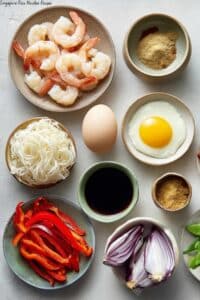
Variations
I love to mix this Singapore Rice Noodles Recipe up depending on what I have or the occasion. Feel free to adjust it to make it your own—you might discover a new favorite way to enjoy it!
- Vegetarian version: Swap the shrimp and pork for firm tofu and extra veggies like mushrooms or baby corn. It’s just as satisfying and colorful.
- Spice it up: Add a bit of chili paste or fresh chilies if you enjoy some heat. I often do this when I crave a kick.
- More protein: Swap shrimp for chicken or add a fried egg on top for extra richness.
- Gluten-free: Just make sure your soy sauce is tamari or gluten-free, and the rest of the ingredients are naturally gluten-free.
- Seasonal tweaks: Swap snow peas for zucchini or asparagus in spring, or add bean sprouts for crunch.
How to Make Singapore Rice Noodles Recipe
Step 1: Prep Your Noodles and Ingredients
Start by soaking the dried rice stick noodles in warm water until they’re just tender—usually about 10 minutes. Drain them well because soggy noodles can turn your dish mushy. While they soak, rinse and pat your shrimp dry, julienne your veggies, thinly slice the pork, and whisk the eggs with salt. Having everything ready before heat hits the pan makes this recipe a breeze.
Step 2: Cook the Eggs and Shrimp
Heat 2 teaspoons of oil in a large wok or skillet over medium-high heat. Pour in your beaten eggs and scramble gently until just set. Remove them and set aside. Next, add a bit more oil, and toss in the shrimp with half the fish sauce and a pinch of curry powder. Cook until pink and just opaque—don’t overcook shrimp! Remove shrimp and keep warm.
Step 3: Stir-Fry Veggies and Pork
Add the remaining oil to the pan and toss in garlic and onions. Stir-fry till fragrant and onions soften slightly. Then throw in your bell pepper, snow peas, and carrots. After a minute or two, add the sliced char siu pork. This step builds the layers of flavor and texture that make the dish exciting.
Step 4: Add Noodles and Seasonings
Push everything to the side of the wok and add the drained noodles. Sprinkle the remaining curry powder, soy sauce, Shaoxing wine, white pepper, sugar, and the remaining fish sauce. Toss everything together to coat the noodles evenly with the spices and mix with the other ingredients. The noodles will soak up all that lovely flavor while heating through.
Step 5: Finish and Serve
Finally, add back the scrambled eggs, sprinkle sliced scallions, and drizzle sesame oil over the whole dish. Give it one last toss and check seasoning—add salt if needed. Serve immediately so you can enjoy the noodles at their best texture and temperature.
How to Serve Singapore Rice Noodles Recipe
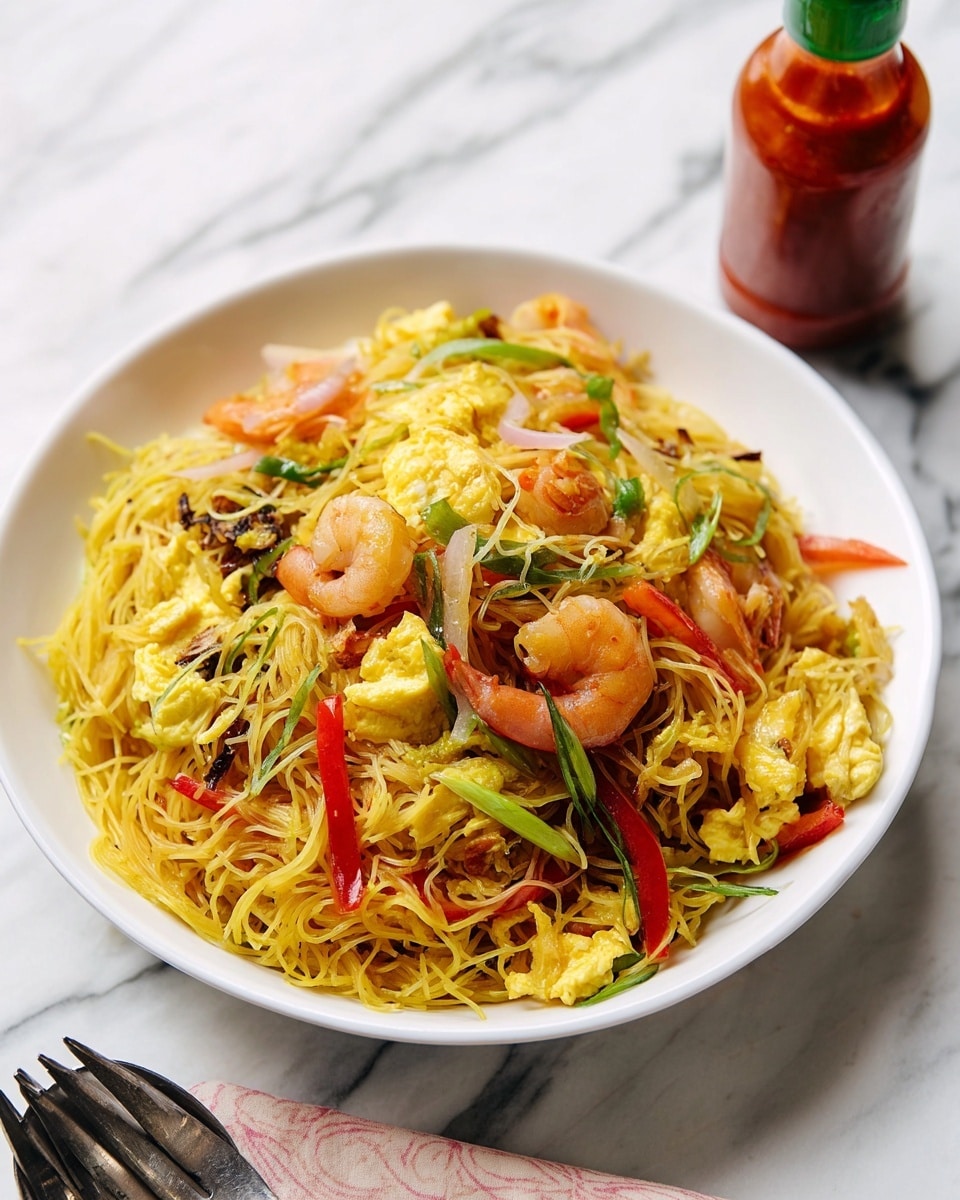
Garnishes
I always top this dish with extra scallions and a sprinkle of toasted sesame seeds if I have them on hand. Sometimes a wedge of lime adds a lovely brightness, or a few fresh cilantro leaves for that herbal lift. These small touches take the dish from homey to dining-out delicious.
Side Dishes
Serving this Singapore Rice Noodles Recipe with a simple cucumber salad or pickled veggies balances the spices and richness nicely. I’ve also enjoyed it alongside steamed dumplings or a light miso soup to make a fuller spread.
Creative Ways to Present
When hosting, I like to plate these noodles in shallow bowls and garnish with thinly sliced chilies and crushed peanuts for texture. For family meals, tossing everything on a big platter and letting everyone help themselves creates a fun, casual vibe.
Make Ahead and Storage
Storing Leftovers
I store leftover Singapore Rice Noodles Recipe in an airtight container in the fridge. The noodles tend to firm up as they cool, so I try to eat them within 1-2 days for the best texture.
Freezing
While you can freeze these noodles, the texture doesn’t hold up perfectly after thawing; the noodles become a bit softer. I usually recommend freezing only if you’re in a pinch and plan to reheat thoroughly.
Reheating
When reheating, I prefer to toss the leftovers in a hot pan with a splash of oil or water to steam and loosen the noodles. Microwaving works in a pinch but can make the noodles stickier. Stir-frying revives that fresh, just-cooked texture.
FAQs
-
What type of noodles work best for Singapore Rice Noodles Recipe?
Dried rice stick noodles are ideal because they have the perfect thinness and texture that soak up the curry and sauces well. Avoid thick noodles because they won’t stir-fry evenly and won’t give you that classic mouthfeel.
-
Can I make this recipe gluten-free?
Absolutely! Use gluten-free tamari instead of soy sauce and double-check that the fish sauce you use doesn’t contain wheat. The rest of the ingredients are naturally gluten-free, making it easy to adapt.
- Is curry powder essential in this recipe?
Yes, the curry powder is what lends this noodle dish its signature flavor and warmth. While you can experiment with alternatives, the curry powder really defines the Singapore Rice Noodles Recipe.
- How do I avoid clumpy noodles?
Make sure to soak the noodles properly and drain them well before cooking. During stir-fry, keep everything moving in the pan on high heat, and toss noodles gently. Adding a bit of oil helps keep them separate.
- Can I substitute the pork?
You can! If you don’t have char siu, ham or even cooked chicken works well. Just cut into thin strips to keep the texture consistent throughout the dish.
Final Thoughts
This Singapore Rice Noodles Recipe holds a special place in my heart because it’s both comforting and exciting—perfect for bringing a little adventure to your dinner table. Once you try it, I’m sure you’ll appreciate how simple ingredients come together in such a vibrant, flavorful meal. Give it a go next time you want something fast, fresh, and packed with character. You really can’t go wrong!
Print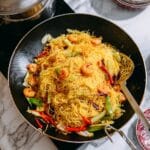
Singapore Rice Noodles Recipe
- Prep Time: 20 minutes
- Cook Time: 15 minutes
- Total Time: 35 minutes
- Yield: 4 servings 1x
- Category: Main Course
- Method: Stovetop
- Cuisine: Singaporean
Description
Singapore Rice Noodles is a vibrant and flavorful stir-fried dish featuring tender shrimp, Chinese roast pork, and crisp vegetables tossed with delicate rice noodles in a fragrant curry powder sauce. This quick and easy recipe showcases a perfect balance of savory, sweet, and spicy flavors, making it a popular choice for a satisfying Asian-inspired meal.
Ingredients
Seafood and Meat
- 1/4 pound shrimp, shelled, deveined, and rinsed under cold water
- 1/4 pound Chinese roast pork (char siu) or ham, cut into thin strips
Noodles
- 1 bundle (about 5 1/2 ounces) dried rice stick noodles
Vegetables
- 2 medium cloves garlic, minced
- 1/4 medium onion, very thinly sliced
- 1/2 medium red bell pepper, stemmed, seeded and julienned
- 12 snow peas, stemmed, tough strings removed, and sliced thinly on the bias
- 1/2 medium carrot, julienned
- 2 scallions, sliced very thinly on the bias
Seasonings and Oils
- 4 tablespoons plus 2 teaspoons canola or vegetable oil, divided
- 2 1/2 teaspoons Asian fish sauce, divided
- 1 tablespoon curry powder, divided
- 1 teaspoon soy sauce
- 1 teaspoon Shaoxing wine
- 1/4 teaspoon ground white pepper
- 1/4 teaspoon sugar
- 2 teaspoons toasted sesame oil
- Kosher salt to taste
Eggs
- 2 eggs, beaten with two pinches kosher salt
Instructions
- Prepare the Noodles: Soak the dried rice stick noodles in warm water according to package instructions until softened but still firm. Drain and set aside.
- Cook the Eggs: Heat 2 teaspoons of oil in a large wok or skillet over medium-high heat. Pour in the beaten eggs and cook, stirring gently until softly scrambled. Remove eggs from the pan and set aside.
- Stir-fry Shrimp: Add 2 tablespoons of oil to the wok and stir-fry the shrimp until they turn pink and are just cooked through. Remove shrimp and set aside with the eggs.
- Sauté Aromatics and Vegetables: Add remaining oil to the wok, then sauté the minced garlic and sliced onions until fragrant and translucent. Add the julienned red bell pepper, snow peas, and carrots. Stir-fry briefly to keep vegetables crisp-tender.
- Add Seasonings: Sprinkle half the curry powder over the vegetables. Add soy sauce, Shaoxing wine, fish sauce, white pepper, and sugar. Stir well to combine and release the aroma of the curry.
- Combine Noodles and Meats: Add the drained rice noodles, cooked shrimp, scrambled eggs, and sliced Chinese roast pork into the wok. Toss everything together over medium-high heat, sprinkling the remaining curry powder and fish sauce as you stir to evenly coat the noodles. Adjust seasoning with kosher salt if needed.
- Finish the Dish: Drizzle toasted sesame oil over the noodles and stir once more to incorporate the flavor. Garnish with thinly sliced scallions for a fresh, green touch.
- Serve: Transfer the Singapore Rice Noodles to a serving dish and enjoy immediately for the best texture and flavor.
Notes
- For best results, soak rice noodles just until pliable; avoid over-soaking to prevent mushy texture.
- Char siu (Chinese roast pork) can be found at Asian markets or substituted with cooked ham if unavailable.
- Curry powder brands vary in heat and flavor, so adjust the quantity based on personal preference.
- Shaoxing wine adds a unique depth; if unavailable, dry sherry is a suitable substitute.
- Vegetables can be varied based on seasonality or preference, such as adding bean sprouts or bok choy.
Keywords: Singapore Rice Noodles, curry noodles, stir-fried rice noodles, Asian rice noodles, Chinese roast pork noodles

